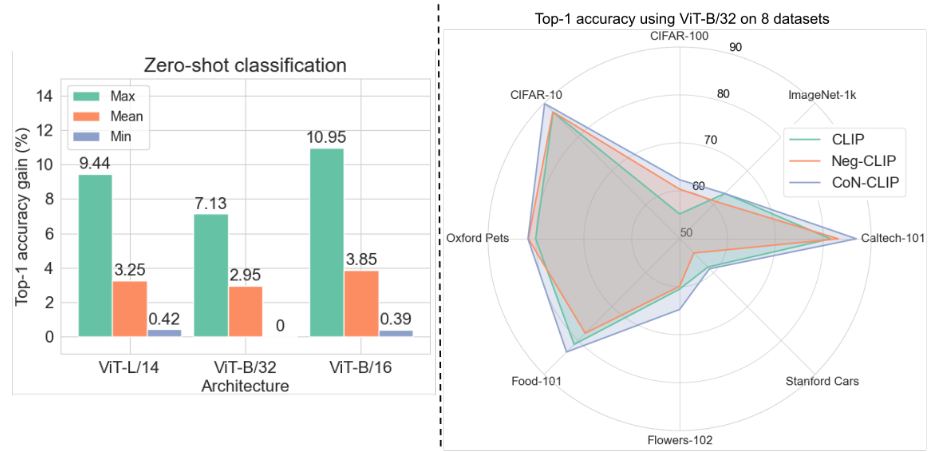This repository releases the official code, checkpoints, and data for our paper (arXiv preprint can be found here). The following provides CoN-CLIP checkpoints and usage instructions for the ViT-L/14, ViT-B/16, and ViT-B/32 backbones of CLIP. Our dataset CC-Neg is being prepared for release and will be added to this repository very soon.
The checkpoints for CoN-CLIP are given in the table below. Note that since these are OneDrive links, it can be useful to use a command line tool given here.
| Model name | CLIP Backbone | Checkpoint |
|---|---|---|
| CoN-CLIP ViT-B/32 | ViT-B/32 | Link |
| CoN-CLIP ViT-B/16 | ViT-B/16 | Link |
| CoN-CLIP ViT-L/14 | ViT-L/14 | Link |
The checkpoint contains the model weights, the optimizer state, and fine-tuning logs. To access and load the model weights, the following code snippet can be used.
import clip
import torch
from PIL import Image
def load_checkpoint(model, checkpoint_path):
ckpt = torch.load(checkpoint_path)
model = model.float()
model.load_state_dict(ckpt["model"])
return model
# the .pt file downloaded from the links above
checkpoint_path = "ckpt_5_conclip_b32.pt"
device = "cuda"
model, preprocess = clip.load("ViT-B/32", device=device)
model = load_checkpoint(model, checkpoint_path)
model = model.to(device)
# now you can use the model as you would use any CLIP model.
image = preprocess(Image.open("dog.jpeg")).unsqueeze(0).to(device)
texts = ["this is a photo of a dog", "this is not a photo of a dog"]
texts_tokenized = clip.tokenize(texts).to(device)
with torch.no_grad():
image_features = model.encode_image(image)
text_features = model.encode_text(texts_tokenized)
image_features /= image_features.norm(dim=-1, keepdim=True)
text_features /= text_features.norm(dim=-1, keepdim=True)
sim = (100 * image_features @ text_features.T).softmax(dim=-1)
print(sim)Detailed instructions for downloading and setting up our CC-Neg dataset are given here. The ccneg_dataset directory stores this data by default.
After setting up the dataset as per the instructions given , the CC-Neg dataset can be loaded for evaluating CLIP-like VLMs using the following code snippet.
import clip
from tqdm import tqdm
from data import CCNegEvalDataset
from torch.utils.data import DataLoader
device = "cuda"
model_name = "ViT-B/32"
def collate_fn(batch):
images = [item[0] for item in batch]
true_captions = [item[1][0] for item in batch]
negated_captions = [item[2][0] for item in batch]
return (images, true_captions, negated_captions)
@torch.no_grad()
def evaluate_clip_on_ccneg():
model, preprocess = clip.load(model_name, device=device)
ccneg_dataset = CCNegEvalDataset(transform=preprocess)
# (transformed_image_tensor, [true_caption], [false_caption]) = ccneg_dataset[0]
loader = DataLoader(ccneg_dataset, batch_size=200, pin_memory=True, collate_fn=collate_fn)
bar = tqdm(total=len(loader))
correct, total = 0, 0
for (images, true_captions, negated_captions) in loader:
batch_size = images.shape[0]
images = images.float().to(device)
true_captions = clip.tokenize(true_captions).to(device)
negated_captions = clip.tokenize(negated_captions).to(device)
image_features = model.encode_image(images) # shape: [batch_size x embedding_dim]
true_caption_features = model.encode_text(true_captions) # shape: [batch_size x embedding_dim]
negated_caption_features = model.encode_text(negated_captions) # shape: [batch_size x embedding_dim]
sim_dense_true = (model.logit_scale * image_features @ true_caption_features.T) # shape: [batch_size x batch_size]
sim_true = torch.diag(sim_dense_true).view(batch_size, 1) # shape: [batch_size x 1] (similarity of the image to its true caption)
sim_dense_neg = (model.logit_scale * image_features @ negated_caption_features.T) # shape: [batch_size x batch_size]
sim_neg = torch.diag(sim_dense_neg).view(batch_size, 1) # shape: [batch_size x 1] (similarity of the image to its true caption)
sim = torch.cat([sim_true, sim_neg], dim=1)
preds = sim.argmax(dim=-1)
labels = torch.zeros(batch_size).to(device) # since true captions are at column 1 in `sim`
correct += (preds == labels).sum().item()
total += batch_size
accuracy = round(correct/total * 100, 2)
bar.set_postfix({"accuracy": accuracy})
bar.update(1)Our model CoN-CLIP can be prepared by fine-tuning CLIP using CC-Neg. This can be done using the src/conclip_fine_tuning.py file. For convenience, we run this file using a shell script with elucidated args. The following command can be used to launch that shell script.
cd src
sh run_finetuning.shOur paper reports the performance of CoN-CLIP on the zero-shot image classification task. We use 8 datasets: ImageNet-1k, CIFAR-100, CIFAR-10, Stanford Cars, Caltech-101, Food-101, Flowers-102, and Oxford Pets. These datasets can be downloaded and prepared from their respective sources and can be used to evaluate CoN-CLIP, yielding results similar to the following.
For the compositional understanding task, our paper uses SugarCREPE, an unbiased dataset used to evaluate the compositionality of VLMs. We find that CoN-CLIP outperforms CLIP on this task and domain, as do variants of it when
If you found our work helpful in your research, please cite it using the following bibtex snippet.
@misc{singh2024learn,
title={Learn "No" to Say "Yes" Better: Improving Vision-Language Models via Negations},
author={Jaisidh Singh and Ishaan Shrivastava and Mayank Vatsa and Richa Singh and Aparna Bharati},
year={2024},
eprint={2403.20312},
archivePrefix={arXiv},
primaryClass={cs.CV}
}



